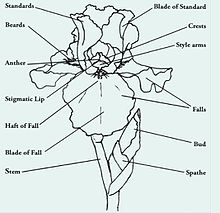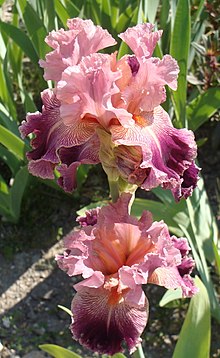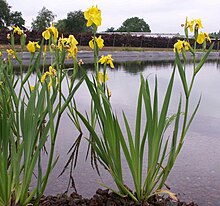Iris (plant)
| Iris | |
|---|---|

| |
| Iris sibirica | |
| Scientific classification | |
| Kingdom: | Plantae |
| Clade: | Tracheophytes |
| Clade: | Angiosperms |
| Clade: | Monocots |
| Order: | Asparagales |
| Family: | Iridaceae |
| Subfamily: | Iridoideae |
| Tribe: | Irideae |
| Genus: | Iris L., 1753 |
| Type species | |
| Iris germanica L.
| |
| Subgenera | |
| Synonyms | |
|
Belamcanda | |
Iris is a genus of 260–300[1][2] species of flowering plants with showy flowers. It takes its name from the Greek word for a rainbow, which is also the name for the Greek goddess of the rainbow, Iris. Some authors state that the name refers to the wide variety of flower colors found among the many species.[3] As well as being the scientific name, iris is also widely used as a common name for all Iris species, as well as some belonging to other closely related genera. A common name for some species is 'flags', while the plants of the subgenus Scorpiris are widely known as 'junos', particularly in horticulture. It is a popular garden flower.
The often-segregated, monotypic genera Belamcanda (blackberry lily, I. domestica), Hermodactylus (snake's head iris, I. tuberosa), and Pardanthopsis (vesper iris, I. dichotoma) are currently included in Iris.
Three Iris varieties are used in the Iris flower data set outlined by Ronald Fisher in his 1936 paper The use of multiple measurements in taxonomic problems as an example of linear discriminant analysis.[4]
Description[edit]
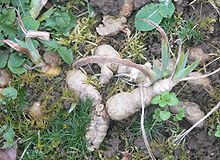
Irises are perennial plants, growing from creeping rhizomes (rhizomatous irises) or, in drier climates, from bulbs (bulbous irises). They have long, erect flowering stems which may be simple or branched, solid or hollow, and flattened or have a circular cross-section. The rhizomatous species usually have 3–10 basal sword-shaped leaves growing in dense clumps. The bulbous species have cylindrical, basal leaves.
Flower[edit]
The inflorescences are in the shape of a fan and contain one or more symmetrical six-lobed flowers. These grow on a pedicel or peduncle. The three sepals, which are usually spreading or droop downwards, are referred to as "falls". They expand from their narrow base (the "claw" or "haft"[5] ), into a broader expanded portion ("limb" or "blade"[6]) and can be adorned with veining, lines or dots. In the centre of the blade, some of the rhizomatous irises have a "beard" (a tuft of short upright extensions growing in its midline),[7] which are the plant's filaments.[8]
The three, sometimes reduced, petals stand upright, partly behind the sepal bases. They are called "standards". Some smaller iris species have all six lobes pointing straight outwards, but generally limb and standards differ markedly in appearance. They are united at their base into a floral tube that lies above the ovary (known as an epigynous or inferior ovary). The styles divide towards the apex into petaloid branches; this is significant in pollination.
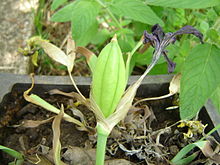
The iris flower is of interest as an example of the relation between flowering plants and pollinating insects. The shape of the flower and the position of the pollen-receiving and stigmatic surfaces on the outer petals form a landing-stage for a flying insect, which in probing for nectar, will first come into contact with the perianth, then with the stigmatic stamens in one whorled surface which is borne on an ovary formed of three carpels. The shelf-like transverse projection on the inner whorled underside of the stamens is beneath the overarching style arm below the stigma, so that the insect comes in contact with its pollen-covered surface only after passing the stigma; in backing out of the flower it will come in contact only with the non-receptive lower face of the stigma. Thus, an insect bearing pollen from one flower will, in entering a second, deposit the pollen on the stigma; in backing out of a flower, the pollen which it bears will not be rubbed off on the stigma of the same flower.[9]
The iris fruit is a capsule which opens up in three parts to reveal the numerous seeds within. In some species, the seeds bear an aril.
Taxonomy[edit]
Iris is the largest genus of the family Iridaceae with up to 300 species – many of them natural hybrids.[10] Modern classifications, starting with Dykes (1913), have subdivided them. Dykes referred to the major subgroupings as sections. Subsequent authors such as Lawrence (1953) and Rodionenko (1987) have generally called them subgenera, while essentially retaining Dykes' groupings, using six subgenera further divided into twelve sections. Of these, section Limneris (subgenus Limneris) was further divided into sixteen series. Like some older sources, Rodionenko moved some of the bulbous subgenera (Xiphium, Scorpiris and Hermodactyloides) into separate genera (Xiphion, Juno and Iridodictyum respectively), but this has not been accepted by later writers such as Mathew (1989), although the latter kept Hermodactylus as a distinct genus, to include Hermodactylus tuberosus, now returned to Hermodactyloides as Iris tuberosa.[10]
Rodionenko also reduced the number of sections in subgenus Iris, from six to two, depending on the presence (Hexapogon) or absence (Iris) of arils on the seeds, referred to as arilate or nonarilate. Taylor (1976) provides arguments for not including all arilate species in Hexapogon.[10]
In general, modern classifications usually recognise six subgenera, of which five are restricted to the Old World; the sixth (subgenus Limniris) has a Holarctic distribution. The two largest subgenera are further divided into sections.
Subgeneric division[edit]
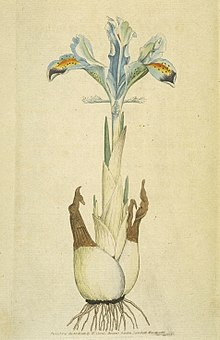
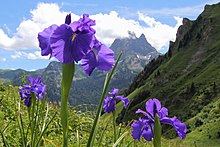
Subgenera[edit]
- Iris (Bearded rhizomatous irises)
- Limniris (Beardless rhizomatous irises)
- Xiphium (Smooth-bulbed bulbous irises: Formerly genus Xiphion)
- Nepalensis (Bulbous irises: Formerly genus Junopsis)
- Scorpiris (Smooth-bulbed bulbous irises: Formerly genus Juno)
- Hermodactyloides (Reticulate-bulbed bulbous irises: Formerly genus Iridodictyum)
Sections, series and species[edit]
Distribution and habitat[edit]
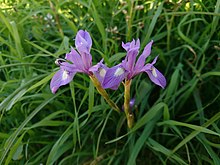

Nearly all species are found in temperate Northern hemisphere zones, from Europe to Asia and across North America. Although diverse in ecology, Iris is predominantly found in dry, semi-desert, or colder rocky mountainous areas,[10] other habitats include grassy slopes, meadowlands, bogs and riverbanks.
Cultivation[edit]

Iris is extensively grown as ornamental plant in home and botanical gardens. Presby Memorial Iris Gardens in New Jersey, for example, is a living iris museum with over 10,000 plants, while in Europe the most famous iris garden is arguably the Giardino dell'Iris in Florence (Italy) which every year hosts a well attended iris breeders' competition. Irises, especially the multitude of bearded types, feature regularly in shows such as the Chelsea Flower Show.
For garden cultivation, iris classification differs from taxonomic classification. Garden iris are classed as either bulb iris or rhizome iris (called rhizomatous) with a number of further subdivisions. Due to a wide variety of geographic origins, and thus great genetic diversity, cultivation needs of iris vary greatly.
Iris grow well in most any garden soil types providing they are well-drained. The earliest to bloom are species like I. junonia and I. reichenbachii, which flower as early as February and March in the Northern Hemisphere, followed by the dwarf forms of I. pumila, and then by most of the tall bearded varieties, such as the German iris and its variety florentina, sweet iris, Hungarian iris, lemon-yellow iris (I. flavescens), Iris sambucina, I. amoena, and their natural and horticultural hybrids such as those described under names like I. neglecta or I. squalens and best united under I. × lurida.
Bearded rhizome iris[edit]
Bearded iris are classified as dwarf, tall, or aril. In Europe, the most commonly found garden iris is a hybrid iris (falsely called German iris, I. germanica which is sterile) and its numerous cultivars. Various wild forms (including Iris aphylla)[11] and naturally occurring hybrids of the Sweet iris (I. pallida) and the Hungarian iris (I. variegata) form the basis of almost all modern hybrid bearded irises. Median forms of bearded iris (intermediate bearded, or IB; miniature tall bearded, or MTB; etc.) are derived from crosses between tall and dwarf species like Iris pumila.
The bearded irises are easy to cultivate and propagate and have become very popular in gardens. A small selection is usually held by garden centres at appropriate times during the season, but there are thousands of cultivars available from specialist suppliers (more than 30 000 cultivars only for the tall bearded irises !). They are best planted as bare root plants in late summer, in a sunny open position with the rhizome visible on the surface of the soil and facing the sun. They should be divided in summer every two or three years, when the clumps become congested.
A truly red bearded iris, like a truly blue rose, remains an unattained goal despite frequent hybridizing and selection. There are species and selections, most notably based on the beardless rhizomatous Copper iris (I. fulva), which have a relatively pure red color. However, getting this color into a modern bearded iris breed has proven very difficult, and thus, the vast majority of irises are in the purple and blue range of the color spectrum, with yellow, pink, orange and white breeds also available.
The following is a selection of bearded irises that have gained the Royal Horticultural Society's Award of Garden Merit:
|
Bearded iris Oncocyclus section[edit]
This section contains the cushion irises or royal irises, a group of plants noted for their large, strongly marked flowers. Between 30 and 60 species are classified in this section, depending on the authority. Compared with other irises the cushion varieties are scantily furnished with narrow sickle-shaped leaves and the flowers are usually borne singly on the stalks; they are often very dark and in some almost blackish.[23] The cushion irises are somewhat fastidious growers, and to be successful with them they must be planted rather shallow in very gritty well-drained soil. They should not be disturbed in the autumn, and after the leaves have withered the roots should be protected from heavy rains until growth starts again naturally.
Bearded iris Regelia section[edit]
This section, closely allied to the cushion irises, includes several garden hybrids with species in section Oncocyclus, known as Regelio-cyclus irises. They are best planted in September or October in warm sunny positions, the rhizomes being lifted the following July after the leaves have withered.
Beardless rhizome iris (subgenus Limniris)[edit]
There are six major subgroupings of the beardless iris, depending on origin. They are divided into Pacific Coast, Siberica, Spuria, Louisiana, Japanese, and other.
Beardless rhizomatous iris types commonly found in the European garden are the Siberian iris (I. sibirica) and its hybrids, and the Japanese Iris (I. ensata) and its hybrids. "Japanese iris" is also a catch-all term for the Japanese iris proper (hanashōbu), the blood iris (I. sanguinea, ayame) and the rabbit-ear iris (I. laevigata, kakitsubata). I. unguicularis is a late-winter-flowering species from Algeria, with sky-blue flowers blotched with yellow, produced from Winter to Spring. Yet another beardless rhizomatous iris popular in gardening is I. ruthenica, which has much the same requirements and characteristics as the tall bearded irises. In North America, Louisiana iris and its hybrids are often cultivated.
Crested rhizome iris (subgenus Limniris)[edit]
One specific species, Iris cristata from North America.
Bulbing juno iris (subgenus Scorpiris)[edit]
Often called 'junos', this type of iris is one of the more popular bulb irises in cultivation. They are generally earliest to bloom.
Bulbing European iris (subgenus Xiphium)[edit]
This group includes irises generally of European descent, and are also classified as Dutch, English, or Spanish iris.
- Iris reticulata and Iris persica, both of which are fragrant, are also popular with florists.
- Iris xiphium, the Spanish Iris (also known as Dutch Iris) and
- Iris latifolia, the English Iris. Despite the common names both the Spanish and English iris are of Spanish origin, and have very showy flowers, so they are popular with gardeners and florists. They are among the hardier bulbous irises, and can be grown in northern Europe. They require to be planted in thoroughly drained beds in very light open soil, moderately enriched, and should have a rather sheltered position. Both these present a long series of beautiful varieties of the most diverse colours, flowering in May, June and July, the smaller Spanish iris being the earlier of the two.
Bulbing reticulate iris (subgenus Hermodactyloides)[edit]
Reticulate irises with their characteristic bulbs, including the yellow I. danfordiae, and the various blue-purple I. histrioides and I. reticulata, flower as early as February and March. These reticulate-bulbed irises are miniatures and popular spring bulbs, being one of the first to bloom in the garden. Many of the smaller species of bulbous iris, being liable to perish from excess of moisture, should have a well-drained bed of good but porous soil made up for them, in some sunny spot, and in winter should be protected by a covering of half-decayed leaves or fresh coco-fiber.
Gallery[edit]
Iris atropurpurea, a dark flowered, bearded Oncocyclus iris
Iris pseudacorus in Cheshire, England, United Kingdom
Iris 'Sharpshooter' in the Real Jardín Botánico de Madrid, Spain
Wild Iris Spuria in Behbahan
Wild Iris Spuria in Behbahan
Uses[edit]
Aromatic rhizomes[edit]

Rhizomes of the German Iris (I. germanica) and Sweet Iris (I. pallida) are traded as orris root and are used in perfume and medicine, though more common in ancient times than today. Today Iris essential oil (absolute) from flowers are sometimes used in aromatherapy as sedative medicines. The dried rhizomes are also given whole to babies to help in teething. Gin brands such as Bombay Sapphire and Magellan Gin use orris root and sometimes iris flowers for flavor and color.[24][25]
For orris root production, iris rhizomes are harvested, dried, and aged for up to 5 years. In this time, the fats and oils inside the roots undergo degradation and oxidation, which produces many fragrant compounds that are valuable in perfumery. The scent is said to be similar to violets. The aged rhizomes are steam-distilled which produces a thick oily compound, known in the perfume industry as "iris butter" or orris oil.
Iris rhizomes also contain notable amounts of terpenes, and organic acids such as ascorbic acid, myristic acid, tridecylenic acid and undecylenic acid. Iris rhizomes can be toxic. Larger blue flag (I. versicolor) and other species often grown in gardens and widely hybridized contain elevated amounts of the toxic glycoside iridin. These rhizomes can cause nausea, vomiting, diarrhea, and/or skin irritation, but poisonings are not normally fatal. Irises should only be used medicinally under professional guidance.
Water purification[edit]
In water purification, yellow iris (I. pseudacorus) is often used. The roots are usually planted in a substrate (e.g. lava-stone) in a reedbed-setup. The roots then improve water quality by consuming nutrient pollutants, such as from agricultural runoff. This highly aggressive grower is now considered a noxious weed and banned in some states of the US where it is found clogging natural waterways.
In culture[edit]
The Iris is one of the flowers listed as birth flower for February.[26] In Christianity, the iris represents Our Lady of Sorrows as its sharp leaves are like swords.[27]
The Iris croatica is the unofficial National Flower of Croatia .[28] Iris nigricans, the Black Iris is the national flower of Jordan.[29] Iris bismarckiana, the Nazareth Iris, is the symbol of the city of Upper Nazareth.[30][31]
In 1998, Iris lacustris, the Dwarf Lake Iris was designated the state wildflower of Michigan,[32][33] where the vast majority of populations exist.[34]
In 1990, the Louisiana iris was voted the state wildflower of Louisiana,[35] though the state flower is the magnolia blossom.[36]
In Iran and Kashmir,[37] Iris kashmiriana and Iris germanica[38] are most commonly grown on Muslim[39] grave yards.[40][41][42]
An iris — species unspecified — is one of the state flowers of Tennessee. It is generally accepted that the species Iris versicolor, the Purple Iris is the state flower[43] alongside the wild-growing purple passionflower (Passiflora incarnata), the state's other floral emblem. Greeneville, Tennessee, is home to the annual Iris Festival celebrating the iris, local customs, and culture.[44] The species Iris versicolor is also the provincial flower of Quebec, having replaced the Madonna lily which is not native to the province.[45] and it is the official flower of Kappa Pi International Honorary Art Fraternity.[46]
The artist George Gessert has specialised in breeding irises.[47]
The artist Vincent van Gogh painted several famous pictures of irises.[48]
The American artist Joseph Mason – a friend of John James Audubon – painted a precise image of what was then known as the Louisiana flag or copper iris (Iris fulva), to which Audubon subsequently added two Northern paraula birds (Parula americana) for inclusion as Plate 15 in his Birds of America.
The artist Philip Hermogenes Calderon painted an iris in his 1856 work Broken Vows; he followed the principles of the Pre-Raphaelite Brotherhood. An ancient belief is that the iris serves as a warning to be heeded, as it was named for the messenger of Olympus. It also conveys images of lost love and silent grief, for young girls were led into the afterlife by Iris. Broken Vows was accompanied with poetry by Henry Wadsworth Longfellow when it was first exhibited.[49]
French King Clovis I (466–511), when he converted to Christianity, changed his symbol on his banner from three toads to irises (the Virgin's flower).[50]
The fleur-de-lis, a stylized iris, first occurs in its modern use as the emblem of the House of Capet. The fleur-de-lis has been associated with France since Louis VII adopted it as a symbol in the 12th century. The yellow fleur-de-lis reflects the yellow iris (I. pseudacorus), common in Western Europe. Contemporary uses can be seen in the Quebec flag and the logo of the New Orleans Saints professional football team and on the flag of Saint Louis, Missouri.
The red fleur-de-lis in the coat-of-arms and flag of Florence, Italy, descends from the white iris which is native to Florence and which grew even in its city walls. This white iris displayed against a red background was the symbol of Florence until the Medici family reversed the colors to signal a change in political power, setting in motion a centuries-long and still on-going breeding program to hybridize a red iris.
The fleur-de-lis is the almost-universal symbol of Scouting and one of the symbols adopted by the sorority Kappa Kappa Gamma.
A stylized yellow iris is the symbol of Brussels, since historically the important Saint Gaugericus Island was carpeted in them.[51] The iris symbol is now the sole feature on the flag of the Brussels-Capital Region. The provincial flower of Québec (Canada) is the harlequin blueflag (I. versicolor), called iris versicolore in French.
It is thought in China, that Iris anguifuga has the ability to keep snakes from entering the garden. It grows all winter, keeping snakes out, but then goes dormant in the spring, allowing the snakes back into the garden. In the autumn, the iris re-appears and can stop the snakes again.[52][53]
In the Homeric Hymn to Demeter, the goddess Persephone and her companion nymphs (the Oceanids along with Artemis and Athena) were gathering flowers such as rose, crocus, violet, iris (also called 'agallis' or ἀγαλλίς (in Greek script),[54] lily, larkspur,[55] and hyacinth[56] in a springtime meadow before she was abducted by the god Hades.[55]
It has been suggested that the 'agallis' mentioned was a dwarf iris, as described by leaf and root shape,[57]) and identified as Iris attica.[58][59]
Gallery[edit]
Philip Hermogenes Calderon's Broken Vows with the iris at lower left
Early coat-of-arms of the House of Capet (France ancient)
See also[edit]
References[edit]
- ^ "WCSP: Iris". World Checklist of Selected Plant Families. Retrieved 2 June 2014.
- ^ "Iris". Pacific Bulb Society. 2011-11-26. Retrieved 2012-03-03.
- ^ Manning, John; Goldblatt, Peter (2008). The Iris Family: Natural History & Classification. Portland, Oregon: Timber Press. pp. 200–204. ISBN 978-0-88192-897-6.
- ^ R. A. Fisher (1936). "The use of multiple measurements in taxonomic problems" (PDF). Annals of Eugenics. 7 (2): 179–188. doi:10.1111/j.1469-1809.1936.tb02137.x. hdl:2440/15227.
- ^ "Parts of an Iris Flower". merlebleu. Archived from the original on 2016-03-04. Retrieved 28 August 2015.
- ^ Donald Wyman Wyman's Gardening Encyclopedia, p. 574, at Google Books
- ^ Lorraine HarrisonLatin for Gardeners: Over 3,000 Plant Names Explained and Explored, p. 141, at Google Books
- ^ "The Beauty and Function of the Iris Flower". wordpress.com. 2011-04-03. Retrieved 28 August 2015.
- ^ Pat Willmer Pollination and Floral Ecology, p. 78, at Google Books
- ^ a b c d Rina Kamenetsky; Hiroshi Okubo, eds. (2012). "Iridaceae". Ornamental Geophytes: From Basic Science to Sustainable Production. CRC Press. p. 24. ISBN 978-1-4398-4924-8.
- ^ Austin, Claire (2005). Irises; A Garden Encyclopedia. Timber Press. p. 124. ISBN 978-0881927306.
- ^ "RHS Plant Selector – Iris 'Alizes'". Royal Horticultural Society. Archived from the original on 24 December 2012. Retrieved 20 May 2013.
- ^ "RHS Plant Selector – Iris 'Bumblebee Deelite'". Royal Horticultural Society. Archived from the original on 25 December 2012. Retrieved 20 May 2013.
- ^ "RHS Plant Selector – Iris 'Early Light'". Royal Horticultural Society. Archived from the original on 24 December 2012. Retrieved 20 May 2013.
- ^ "RHS Plant Selector – Iris 'Jane Phillips'". Royal Horticultural Society. Archived from the original on 24 December 2012. Retrieved 20 May 2013.
- ^ "RHS Plant Selector – Iris 'Langport Wren'". Royal Horticultural Society. Archived from the original on 24 December 2012. Retrieved 20 May 2013.
- ^ "RHS Plant Selector – Iris 'Maui Moonlight'". Royal Horticultural Society. Archived from the original on 24 December 2012. Retrieved 20 May 2013.
- ^ "RHS Plant Selector – Iris 'Orinoco Flow'". Royal Horticultural Society. Archived from the original on 24 December 2012. Retrieved 20 May 2013.
- ^ "RHS Plant Selector – Iris 'Raspberry Blush'". Royal Horticultural Society. Archived from the original on 24 December 2012. Retrieved 20 May 2013.
- ^ "RHS Plant Selector – Iris 'Sarah Taylor'". Royal Horticultural Society. Archived from the original on 24 December 2012. Retrieved 20 May 2013.
- ^ "RHS Plant Selector – Iris 'Thornbird'". Royal Horticultural Society. Archived from the original on 25 December 2012. Retrieved 20 May 2013.
- ^ "RHS Plant Selector – Iris 'Titan's Glory'". Royal Horticultural Society. Archived from the original on 24 December 2012. Retrieved 20 May 2013.
- ^ Wilson, Carol A.; Padiernos, Justin; Sapir, Yuval (February 2016). "The royal irises (Iris subg. Iris sect. Oncocyclus): Plastid and low-copy nuclear data contribute to an understanding of their phylogenetic relationships". Taxon. 65 (1): 35–46. doi:10.12705/651.3. Retrieved 4 January 2018.
- ^ Kathi Keville The Aromatherapy Garden: Growing Fragrant Plants for Happiness and Well-Being, p. 397, at Google Books
- ^ "Magellan Gin". theginisin.com. 2011-01-29. Retrieved 29 May 2018.
- ^ "Birth Month Flower of February - The Iris". 1st in Flowers!.
- ^ Kostka, Arun Oswin. "Flowers in Christian Symbolism".
- ^ James Minahan The Complete Guide to National Symbols and Emblems (2 Volumes), p. 364, at Google Books
- ^ "Wildlife and Vegetation". kinghussein.gov.jo. Government of Jordan. Retrieved 2015-05-10.
- ^ Rinat, Zafrir (11 September 2006). "Caution, Iris Ahead!". haaretz.com. Retrieved 25 July 2016.
- ^ Alon TalAll the Trees of the Forest: Israel's Woodlands from the Bible to the Present, p. 260, at Google Books
- ^ "Iris lacustris Nutt". michiganflora.net. Archived from the original on 5 March 2016. Retrieved 9 April 2015.
- ^ "Michigan State Wildflower". Netstate.com. Retrieved 2012-05-14.
- ^ "Michigan Natural Features Inventory" (PDF). Archived from the original (PDF) on 2011-09-29. Retrieved 2012-05-14.
- ^ Charlotte Seidenberg (1 March 1993). The New Orleans Garden: Gardening in the Gulf South. Univ. Press of Mississippi. p. 223. ISBN 978-0-87805-637-8.
- ^ "Louisiana State Wildflower". statesymbolsusa.org. Retrieved 28 November 2014.
- ^ "Chapter I Rhizomatous Iris (part 2)". irisbotanique.over-blog.com. Retrieved 20 October 2015.
- ^ Singh, Gurcharan. "Kashmir Iris". flowersofindia.net. Retrieved 22 October 2015.
- ^ Stebbings, Geoff (1997). The Gardener's Guide to Growing Irises. Newton Abbot: David and Charles. p. 23. ISBN 978-0715305393.
- ^ British Iris Society (1997) A Guide to Species Irises: Their Identification and Cultivation, p. 38-39, at Google Books
- ^ Austin, Claire (2005). Irises; A Garden Encyclopedia. Timber Press. ISBN 978-0881927306.
- ^ Trak, Touseef Hussain; Upadhayay, Ravi (April 2015). "Ethnobotanical And Taxonomic Study Of Members of Iridaceae Family of Kishtwar, (Jammu And Kashmir) India" (PDF). International Journal of Pharma and Bio Sciences. 6 (2): 779–793. Archived from the original (PDF) on 2016-08-02. Retrieved 22 October 2015.
- ^ "State of Tennessee". state.tn.us.
- ^ "18th Annual Iris Festival". Greenecountypartnership.com. Retrieved 2012-03-03.
- ^ (in French) Gouvernement du Québec Emblèmes du Québec - Iris versicolor
- ^ Article I, Section 2. "International Constitution of Kappa Pi" (PDF). Kappa Pi International Honorary Art Fraternity Inc.[permanent dead link]
- ^ West [2008]
- ^ Pioch (2002)
- ^ Mancoff (2003): pp. 6, 16
- ^ Margaret Grieve A Modern Herbal, Volume 2 (1971), p. 435, at Google Books
- ^ Chancery of the Prime Minister, Kingdom of Belgium [2007]
- ^ "Species and Water Garden Iris". iriscitygardens.com. Retrieved 19 January 2015.
- ^ Kramb, D. (14 September 2004). "Iris anguifuga". signa.org (Species Iris Group of North America). Retrieved 19 January 2015.
- ^ "ἀγαλλίς". lsj.translatum.gr. Retrieved 10 September 2015.
- ^ a b "Flora 1, Plants of Greek Myth". theoi.com. Retrieved 9 September 2015.
- ^ R. P. Winnington-Ingram Sophocles: An Interpretation (1980), p. 116, at Google Books
- ^ Leonhard Schmitz (Editor) The Classical Museum: A Journal of Philology, and of Ancient History and literature, Volume 5 (1848), p. 60, at Google Books
- ^ "Tag Archives: British Iris Society". wiebkerost.com. Retrieved 10 September 2015.
- ^ Umberto Quattrocchi CRC World Dictionary of Medicinal and Poisonous Plants: Common Names, Scientific names, Synonyms and Etymology (2012, p. 128, at Google Books
Bibliography[edit]
- Chancery of the Prime Minister, Kingdom of Belgium [2007]: Brussels Town Hall. Retrieved November 11, 2007.
- Rina Kamenetsky; Hiroshi Okubo, eds. (2012). "Iridaceae". Ornamental Geophytes: From Basic Science to Sustainable Production. CRC Press. p. 24. ISBN 978-1-4398-4924-8.
- Mancoff, Debra N. (2003): Flora Symbolica: Flowers in Pre-Raphaelite Art. Prestel Publishing, New York, USA. ISBN 3-7913-2851-4.
- Pioch, Nicolas (2002): Gogh, Vincent van: Irises. Bersion of 2002-AUG-19. Retrieved December 10, 2008.
- Species Group of the British Iris Society (1996): A Guide to Species Irises: Their Identification and Cultivation; Cambridge University Press, Cambridge, UK. ISBN 0-521-44074-2.
- West, Ruth [2008]: George Gessert. Retrieved December 10, 2008.
Taxonomy[edit]
- American Iris Society. Systematic Treatment of the Genus Iris by Baker. 2012
- Dykes, W. R. (1913): The Genus Iris. Cambridge University Press, Cambridge, UK. ISBN 0486230376
- Harris, Gwenda. CLASSIFICATION OF IRISES. New Zealand Iris Society 2011
- Brian Mathew. The Iris. Batsford, London 1989
- George Hill Mathewson Lawrence. A Reclassification of the Genus Iris. Gentes Herb 8:346-371 1953
- Rodionenko, G. I.: The Genus Iris L. (Questions of Morphology, Biology, Evolution and Systematics). British Iris Society, London 1987. (trans.)
- Taylor, J.J. 1976. A reclassification of Iris species bearing arillate seeds. Proceedings of the Biological Society, Washington. 89: 411-420.
- Wilson, Carol. Phylogeny of the genus Iris based on DNA sequence data. Rancho Santa Ana 2004
External links[edit]
| Wikimedia Commons has media related to Iris (Iridaceae). |
| Wikimedia Commons has media related to Iris cultivars by alphabet. |
- Joseph Mason's painting - Copper Iris Copper Iris / Louisiana Flag (Iris cuprea) from John James Audubon's Birds of America
- Flora of North America: Iris
- Flora of China: Iris
- Flora of Pakistan: Iris
- Flora of Nepal: Iris
- A web site devoted to Irises, by David Payne-Joyce; includes plates from Dykes (1913).
- The American Iris Society
- Historic Iris Preservation Society
- An extensive website about Iris
- Iris listings at Wild Flowers of Israel
- Iris in Art and Culture
- Gouvernement du Québec Emblèmes du Québec - Iris versicolor (French)
